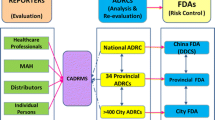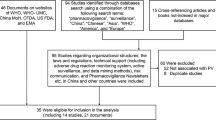Abstract
Introduction
Most Countries have pharmacovigilance (PV) systems in place to monitor the safe use of health products. The process involves the detection and assessment of safety issues from various sources of information, communicating the risk to stakeholders and taking other relevant risk minimization measures.
Objectives
This study aimed to assess the PV status in Association of Southeast Asian Nation (ASEAN) countries, sources for postmarket safety monitoring, methods used for signal detection and the need for a quantitative signal detection algorithm (QSDA). Comparisons were conducted with centres outside ASEAN.
Methods
A questionnaire was sent to all PV centres in ASEAN countries, as well as seven other countries, from November 2015 to June 2016. The questionnaire was designed to collect information on the status of PV, with a focus on the use of a QSDA.
Results
Data were collected from nine ASEAN countries and seven other countries. PV activities were conducted in all these countries, which were at different stages of development. In terms of adverse drug reaction (ADR) reports, the average number received per year ranged from 3 to 50,000 reports for ASEAN countries and from 7000 to 1,103,200 for non-ASEAN countries. Thirty-three percent of ASEAN countries utilized statistical methods to help detect signals from ADR reports compared with 100% in the other non-ASEAN countries. Eighty percent agreed that the development of a QSDA would help in drug signal detection. The main limitation identified was the lack of knowledge and/or lack of resources.
Conclusion
Spontaneous ADR reports from healthcare professionals remains the most frequently used source for safety monitoring. The traditional method of case-by-case review of ADR reports prevailed for signal detection in ASEAN countries. As the reports continue to grow, the development of a QSDA would be useful in helping detect safety signals.




Similar content being viewed by others
References
World Health Organization. The importance of pharmacovigilance: safety monitoring of medicinal products. Geneva: World Health Organisation; 2002.
USA General Accounting Office. FDA drug review—post approval risks 1976–1985. 26 April 1990. GAO IPEMD.90. Available at: http://www.gao.gov/products/PEMD-90-15. Accessed 24 May 2015.
Patel DN, Low WL, Tan LL, Tan MM, Zhang Q, Low MY, et al. Adverse events associated with the use of complementary medicine and health supplements: an analysis of reports in the Singapore pharmacovigilance database from 1998 to 2009. Clin Toxicol (Phila). 2012;50(6):481–9.
Teo D, Ng P, Tan SH, Lim A, Toh D, Chan SY, et al. Drug-induced liver injury associated with complementary and alternative medicine: a review of adverse event reports in an Asian community from 2009 to 2014. BMC Complement Altern Med. 2016;16(1):192.
Council for International Organizations of Medical Sciences. Practical aspects of signal detection in pharmacovigilance: report of CIOMS Working Group VIII on application of signal detection in pharmacovigilance. Geneva: Council for International Organizations of Medical Sciences; 2010.
Edwards IR, Aronson JK. Adverse drug reactions: definitions, diagnosis, and management. Lancet. 2000;356(9237):1255–9.
Wisniewski A, Bate A, Bousquet C, Brueckner A, Candore G, Juhlin K, et al. Good signal detection practices: evidence from IMI PROTECT. Drug Saf. 2016;39(6):469–90.
van Manen RP, Fram D, DuMouchel W. Signal detection methodologies to support effective safety management. Expert Opin Drug Saf. 2007;6(4):451–64.
Norwood P, Sampson A. A statistical methodology for postmarketing surveillance of adverse drug reaction reports. Stat Med. 1988;7(10):1023–30.
Association of Southeast Asian Nations. ASEAN Free Trade Area (AFTA Council). Available at: http://www.asean.org/asean-economic-community/asean-free-trade-area-afta-council. Accessed 24 May 2015.
Dato’ Eisah A. Rahman. Current updates on ASEAN pharmaceutical harmonisation. 5th Asia Partnership Conference of Pharmaceutical Associations; Tokyo, April 2016. Available at: http://apac-asia.com/images/achievements/pdf/5th/ATIM_06_Dato’AISAH.pdf. Accessed 27 Aug 2016.
Olsson S, Pal S, Stergachis A, Couper M. Pharmacovigilance in 55 low- and middle-income countries: a questionnaire-based analysis. Drug Saf. 2010;33(8):689–703.
Wilbur K. Pharmacovigilance in the Middle East: a survey of 13 Arabic-speaking countries. Drug Saf. 2013;36(1):25–30.
Biswas P. Pharmacovigilance in Asia. J Pharmacol Pharmacother. 2013;4(Suppl 1):S7–19.
Nwokike J, Ludeman E, Thumm ME. Comparative pharmacovigilance systems in five Asian countries. US AID, SIAPS, September 2013. Available at: http://apps.who.int/medicinedocs/documents/s21335en/s21335en.pdf. Accessed 24 Dec 2015.
Suwankesawong W, Dhippayom T, Tan-Koi W, Kongkaew C. Pharmacovigilance activities in ASEAN countries. Pharmacoepidemiol Drug Saf. 2016;25(9):1061–9.
Uppsala Monitoring Centre. Vigiflow: advanced concepts. Available at: http://www.who.int/hiv/topics/pharmacovigilance/2_vigiflow_advanced_concepts.pdf. Accessed 31 May 2015.
Stahl M, Lindquist M, Edwards IR, Brown EG. Introducing triage logic as a new strategy for the detection of signals in the WHO Drug Monitoring Database. Pharmacoepidemiol Drug Saf. 2004;13(6):355–63.
Medical Dictionary for Regulatory Activities (MedDRA) Terminology. International Council for Harmonisation of Technical Requirements for Registration of Pharmaceuticals for Human Use (ICH).
Ang PS, Chen Z, Chan CL, Tai BC. Data mining spontaneous adverse drug event reports for safety signals in Singapore—a comparison of three different disproportionality measures. Expert Opin Drug Saf. 2016;15(5):583–90.
Bate A, Evans SJ. Quantitative signal detection using spontaneous ADR reporting. Pharmacoepidemiol Drug Saf. 2009;18(6):427–36.
Egberts AC, Meyboom RH, van Puijenbroek EP. Use of measures of disproportionality in pharmacovigilance: three Dutch examples. Drug Saf. 2002;25(6):453–8.
WHO. Minimum requirements for a functional pharmacovigilance system. Available at: http://www.who.int/medicines/areas/quality_safety/safety_efficacy/PV_Minimum_Requirements_2010_2.pdf. Accessed 3 June 2016.
Huang YL, Moon J, Segal JB. A comparison of active adverse event surveillance systems worldwide. Drug Saf. 2014;37(8):581–96.
Layton D, Hazell L, Shakir S. Modified prescription-event monitoring studies: a tool for pharmacovigilance and risk management. Drug Saf. 2011;34(12):e1–9.
Foundation R-U. Innovation in Medical Evidence Development and Surveillance (IMEDS). 2013. Available at: http://omop.org/sites/default/files/RUF_IMEDS_060613.pdf. Accessed 6 June 2016.
Curtis L, Weiner M, Boudreau D, Cooper W, Daniel G, Nair V, et al. Design considerations, architecture, and use of Mini-sentinel distributed data system. Pharmacoepidemiol Drug Saf. 2012;21(Suppl 1):23–31.
Wysowski D, Swartz L. Adverse drug event surveillance and drug withdrawals in the United States, 1969–2002: the importance of reporting suspected reactions. Arch Intern Med. 2005;165(12):1363–9.
Lim W, editor. Development of medical informatics in Singapore—keeping pace with healthcare challenges. Taipei: Asia Pacific Association for Medical Informatics; 2006.
Hauben M, Patadia V, Gerrits C, Walsh L, Reich L. Data mining in pharmacovigilance: the need for a balanced perspective. Drug Saf. 2005;28(10):835–42.
Therése L. Positive trends for Vigibase—12 million reports & counting: Uppsala reports—Covering the World of Pharmacovigilance; 2016. p. 14–5.
Acknowledgements
The authors thank Prof. Stephen Evans (London School of Hygiene and Tropical Medicine) and Mr. Sten Olsson (Uppsala Monitoring Centre, the WHO Collaborating Centre for International Drug Monitoring, Uppsala, Sweden) for providing comments and feedback to the questionnaire, and Betty Chan for assisting in collation of the results. We would like to acknowledge Dr. Bronwen Harvey (Australia), Rosni Jair (Brunei Darussalam), Hean Kimseat (Cambodia), Jacob Porter (Canada), Suci Yunita Sari and Wilia Indarwanti (Indonesia), Dr. Yusuke Matsunaga (Japan), Dr. Sourisak Sounvoravong (Lao PDR), Rema Panickar (Malaysia), Mark Ryann A. Lirasan (Philippines), Dr. Dorothy Toh and Tan Siew Har (Singapore), Sujin Kim (South Korea), Dr. Valeriu Toma (Switzerland), Sareeya Wechwithan (Thailand), Mick Foy (UK), Allen Brinker (US) and Ngo Thi Huong Minh (Vietnam) for providing valuable information.
Author information
Authors and Affiliations
Corresponding author
Ethics declarations
Funding
No sources of funding were used to assist in the preparation of this study.
Conflict of interest
Cheng Leng Chan, Pei San Ang and Shu Chuen Li have no conflicts of interest to declare that are directly relevant to the content of this study.
Electronic supplementary material
Below is the link to the electronic supplementary material.
Rights and permissions
About this article
Cite this article
Chan, C.L., Ang, P.S. & Li, S.C. A Survey on Pharmacovigilance Activities in ASEAN and Selected Non-ASEAN Countries, and the Use of Quantitative Signal Detection Algorithms. Drug Saf 40, 517–530 (2017). https://doi.org/10.1007/s40264-017-0510-9
Published:
Issue Date:
DOI: https://doi.org/10.1007/s40264-017-0510-9




